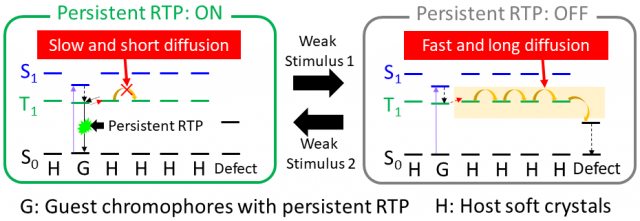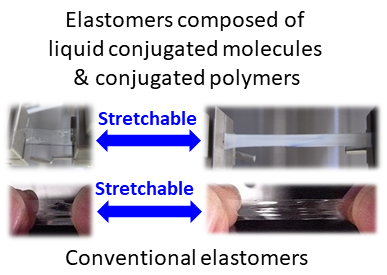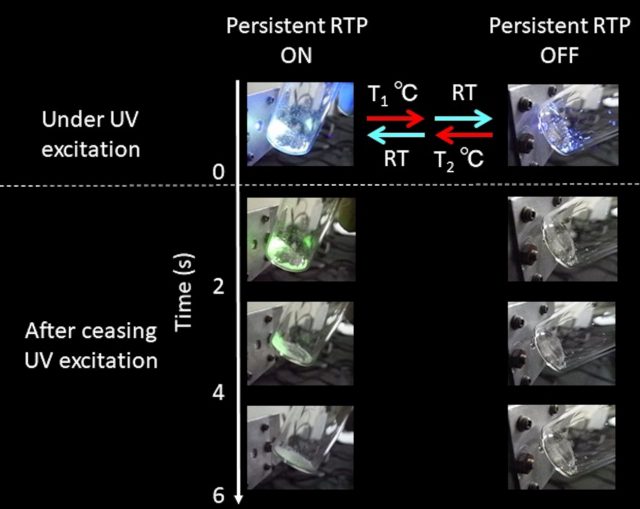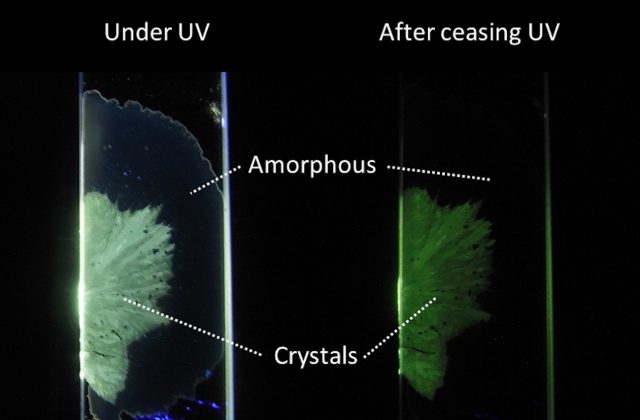Participating Group (2020-2021)
Large Reversible Change of Persistent Room-Temperature Phosphorescence and/or Light Scattering Characteristics Triggered by External Stimulus
Research Outline
Aggregates of conjugated molecules often exhibit stronger intermolecular π-interactions compared with molecularly dispersed conjugated molecules. If the intermolecular π-interactions could be tuned by a weak external stimulus, the stimulus would trigger a large change of the photo-functional characteristics of the aggregates. My research seeks to fabricate materials that are able to reversibly change the persistent emission and/or light scattering characteristics upon exposure to a weak external stimulus. Specifically, the persistent room-temperature phosphorescence (RTP) characteristics of chromophores dispersed in soft crystalline conjugated hosts can be controlled by a reversible change of the diffusion characteristics of the triplet exciton of the hosts, which is triggered by the exposure to different vapors and/or solvents.

Additionally, a reversible switching on and off of light scattering, which depends on stretching elastomers composed of liquid conjugated molecules and conjugated polymers, is investigated. This reversible switching occurs because the stretching of the elastomers greatly changes the intermolecular interactions compared with those observed for conventional elastomers.

The photofunctional characteristics of soft crystals based on these novel mechanisms that are triggered by a large change of intermolecular π-interactions will be determined.
Participating Group (2018-2019)
Mechano-Responsive Persistent Room-Temperature Phosphorescence using Soft Chiral Molecular Crystals
Research Outline
Persistent room-temperature phosphorescence (RTP) of heavy atom-free aromatic crystals can be obtained by suppressing the quenching from the lowest triplet excited state via the increase of molecular rigidity caused by crystallization. The researcher [NL1] [s2] will investigate major factors leading to triplet exciton stabilization in aromatic crystals using a chiral aromatic structure with soft moieties and develop materials with mechanoresponsive circularly polarized persistent RTP characteristics using the soft crystals. The concrete research subjects focused on will be (1) the contribution of the soft moieties to the mechanoresponsive characteristics as well as triplet exciton stabilization and (2) the investigation of the relationship between the aggregation of the chiral aromatic structures and circularly polarized persistent RTP characteristics. This research could potentially clarify the mechanism of the triplet exciton stabilization of aromatic crystals and expand molecular designs of persistent RTP materials. In addition, this investigation may lead to novel functions that are not displayed by conventional inorganic persistent emitters, such as mechanoresponsive circularly polarized persistent RTP characteristics.


Publications
Academic papers/reviewed
A03-13
- " A Rational Key of Triplet Afterglow Sensitizer Allowing Bright Long-Wavelength Afterglow Room-Temperature Emission" K. Hayashi, K. Fukasawa, T. Yamashita, *S. Hirata, Chem. Mater., 34, 1627-1637 (2022) (Supplementary Cover).
- " Key of Suppressed Triplet Nonradiative Transition-Dependent Chemical Backbone for Spatial Self-Tunable Afterglow" I. Bhattacharjee, H. Hayashi, *S. Hirata, JACS. Au, 1, 945-954 (2021).(Front Cover).
- " Molecular Physics of Persistent Room-Temperature Phosphorescence and Long-Lived Triplet Excitons" *S. Hirata, Appl. Phys. Revs., 9, 011304 (2022).(Featured)DOI: 10.1063/5.0066613
- " Thermo-Reversible Persistent Phosphorescence Modulation Reveals the Large Contribution Made by Rigidity to the Suppression of Endothermic Intermolecular Triplet Quenching" T. Kusama, *S. Hirata, Front. Chem., 7, 788577 (2021).
- "Chiral Approach to Investigate Mechanism of Highly Efficient Thermally Activated Delayed Fluorescence" K. Hayashi, A. Matsumoto, *S. Hirata, Chem. Commun. ,57, 1738-1741 (2021).(Inside Front Cover) (領域内共同研究A01公募 松本)DOI: 10.1039/D0CC08064K
- "Highly Efficient Persistent Room‐Temperature Phosphorescence from Heavy Atom‐Free Molecules Triggered by Hidden Long Phosphorescent Antenna" I. Bhattacharjee, *S. Hirata, Adv. Mat., 32, 2001348 (2020).
- "Phosphorescence Quenching of Heavy-Atom-Free Dopant Chromophores Triggered by Thermally Activated Triplet Exciton Diffusion of a Conjugated Crystalline Host" *S. Hirata, H. Hara, I. Bhattacharjee, J. Phys. Chem. C, 124, 25121-25132 (2020).
- "The Substituent-Induced Symmetry-Forbidden Electronic Transition Allows Significant Optical Limiting under Weak Sky-Blue Irradiance" T. Kamatsuki, I. Bhattacharjee, *S. Hirata, J. Phys. Chem. Lett., 11, 8675-8681 (2020).
- "Vibrational Radiationless Transition from Triplet States of Chromophores at Room Temperature" *S. Hirata, I. Bhattacharjee, J. Phys. Chem. A, 125, 885-894 (2021).
- "Roles of Localized Electronic Structures caused by π Degeneracy due to Highly Symmetric Heavy Atom-Free Conjugated Molecular Crystals Leading to Efficient Persistent Room-Temperature Phosphorescence" S. Hirata, Adv. Sci., 6, 2019, 6, 1900410.Frontispiece)
- "Intrinsic Analysis of Radiative and Room-Temperature Nonradiative Processes Based on Triplet State Intramolecular Vibrations of Heavy Atom-Free Conjugated Molecules toward Efficient Persistent Room-Temperature Phosphorescence" S. Hirata, J. Phys. Chem. Lett., 2018, 9, 4251-4259.
- "Suppressed Triplet Exciton Diffusion Due to Small Orbital Overlap as a Key Design Factor for Ultralong-Lived Room-Temperature Phosphorescence in Molecular Crystals" K. Narushima, Y. Kiyota, T. Mori, S. Hirata, M. Vacha, Adv. Mat., 2019, 31, 1807268.
- "Ultralong-Lived Room Temperature Triplet Excitons: Molecular Persistent Room Temperature Phosphorescence and Nonlinear Optical Characteristics with Continuous Irradiation" S. Hirata, J. Mat. Chem. C, 2018, 6, 11785-11794.(Inside Front Cover)DOI: 10.1039/C8TC01417E